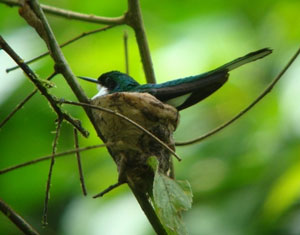Can You Legally Remove That Bird’s Nest?
By Chris Williams on May 30, 2014.
 Bird Nest Question
Bird Nest Question
I’m confused about bird regulations. Are all birds protected by law? I heard that you can’t tear down a bird’s nest that’s on your boat, even if it doesn’t have eggs in it. Is that right?—J. T., Derry, NH
Answer
This is a very involved question to answer correctly, but I’ll do my best. First, here’s the short answer to your question: If the bird’s nest on your boat belongs to a sparrow, starling, or pigeon, you may remove it. If it belongs to any other bird and the nest has been built and is being tended (eggs or not), you are out of luck.
The main federal law that protects birds is the Migratory Bird Treaty Act managed by the U.S. Fish and Wildlife Service. The law was enacted in 1918 to prohibit the flourishing commercial trade in exotic bird feathers. Today, the federal law protects the nesting habits and territory of most of our breeding birds. Basically, it is illegal to kill or possess a migratory bird, to remove, or even touch the nest of a protected bird without a special permit.
You may think that the birds you are dealing with must not be migratory birds, but this law protects most all of the birds that nest in and around your yard, even nonmigrating birds. In New Hampshire, 15% of the breeding birds are not migrants but are year-round resident birds, including woodpeckers, crows, cardinals, and chickadees. These birds enjoy the same protections as more exotic, migrating birds. However, there are three birds that are considered to be pest birds and that are not protected by federal law. Those are the house sparrow, the pigeon, and the starling.
There is a provision though: if protected birds are posing “a threat to themselves, to public health and safety, or to commercial interests.” In these cases (I don’t think your boat will qualify!), some protected birds may be humanely removed with a federal permit which is generally issued to a wildlife relocation contractor.
However (and here’s where it gets complicated), states can have their own regulations, too. For example, in New Hampshire, nineteen bird species have additional protection as a result of the state’s Endangered Species Conservation Act. Individual states may require permits even to control the three pest birds. And then, some counties or communities have initiated their own bird control laws.
Leave Bird Control to Those Who Know the Regs
This is why it’s always a good idea to contact a professional that is experienced in bird management. We know, or can find out, the regulations in your state and community. If you don’t know your state regulations and you don’t know the type of bird that you are dealing with, you’d better leave it alone.
Bird control is all about timing. Once baby birds have fledged or left the nest, you are free to remove the nest. For most small birds, the time from egg laying to fledging takes about a month. But, if you don’t act quickly, there might soon be a second brood in that nest.
If you see a bird starting to build a nest in an inconvenient location, you can immediately remove the nest material. You may have to repeat this on a daily basis before the bird finally gives up. Once a protected bird completes its nest, the only thing you can do is sit back and appreciate the wonders of nature!
Photo credit: Foter / Creative Commons Attribution-ShareAlike 3.0 Unported (CC BY-SA 3.0)